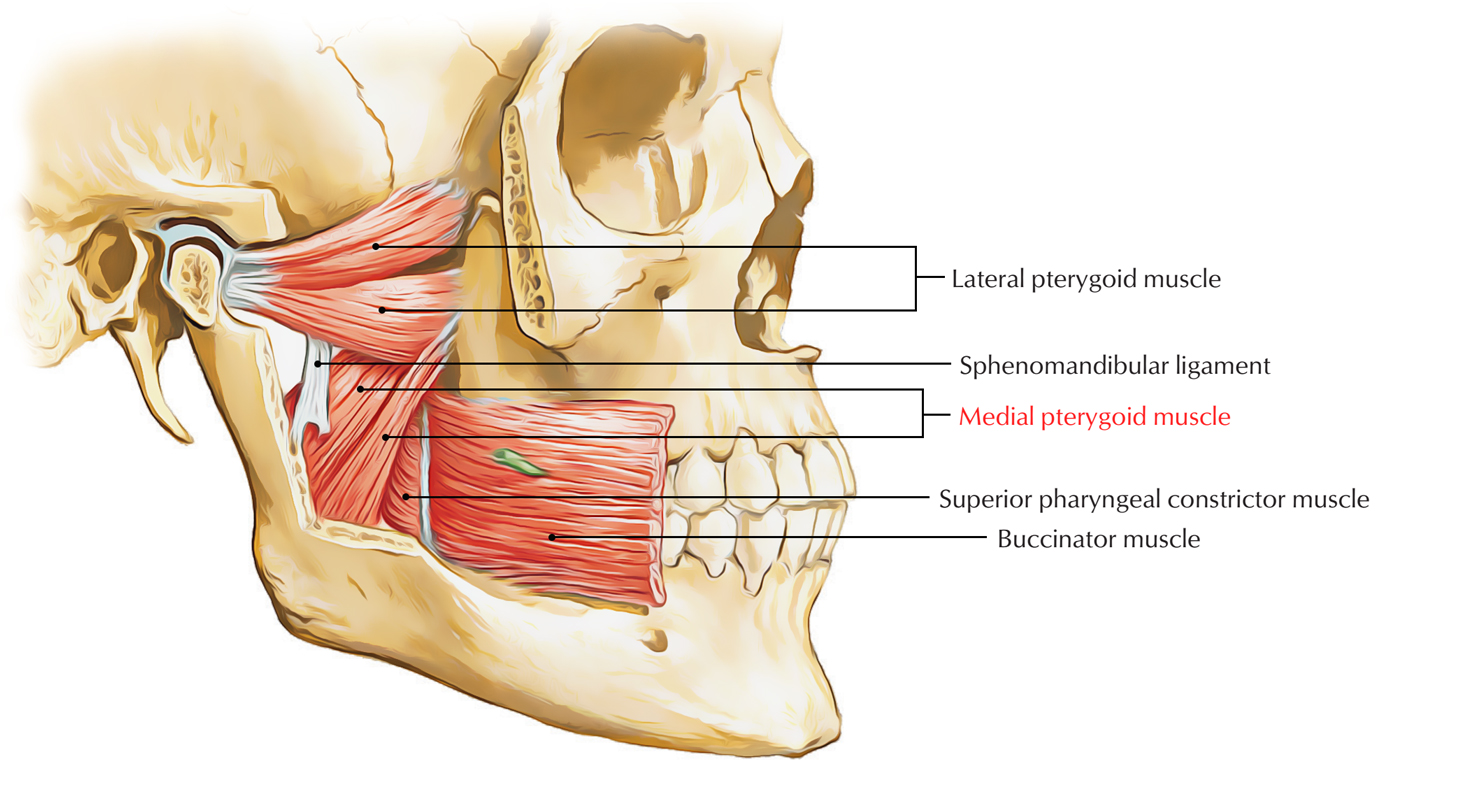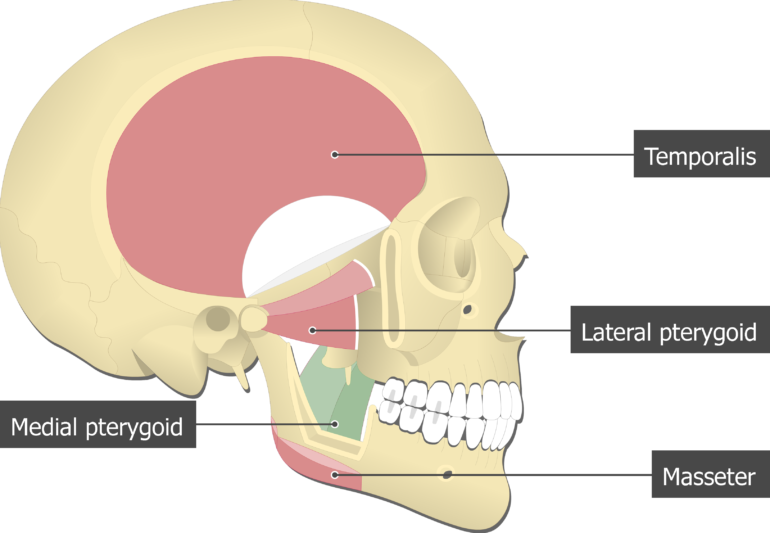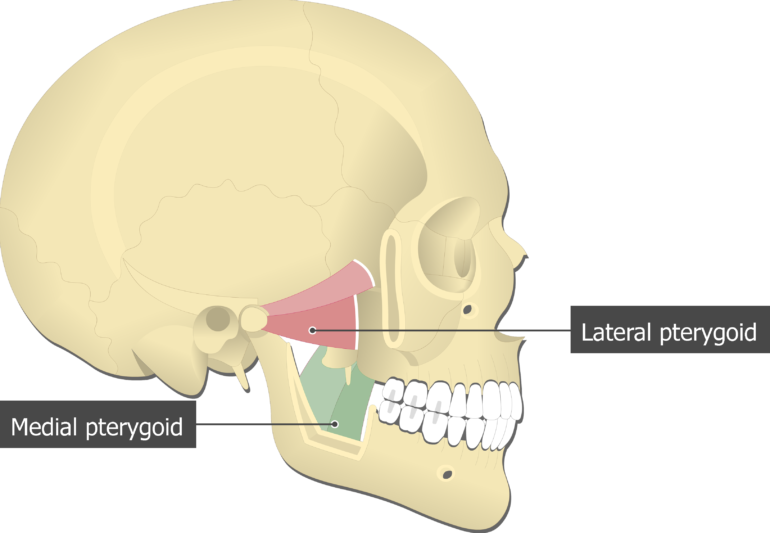The bilateral contraction of this muscle elevates the mandible and closes the mouth. Elevation of the mandible occurs during the closing of the jaws.

Medial Pterygoid Muscle Wikipedia
The medial pterygoid muscle is innervated by the medial pterygoid branch of the mandibular division of the trigeminal nerve CN V3.
:background_color(FFFFFF):format(jpeg)/images/library/14110/Pterygoid_muscles.png)
. The medial pterygoid acts together with masseter to elevate the mandible. The masseter parallels the medial pterygoid muscle but it is stronger and superficial fibres can cause protrusion. It elevates and protrudes the mandible.
The medial pterygoid acts together with masseter to elevate the mandible. Upon bilateral contractions the medial pterygoid muscles push the mandible forward protrude the mandible. The medial pterygoid muscle is one of the four paired muscles of mastication.
This muscle functions to move the lower jaw forward down and side. The masseter muscle is the most powerful muscle of mastication. First bilateral contraction of the muscle with lateral pterygoid muscle results in protrusion of the mandible1 This action results as the muscle fibers are aligned anteroposteriorly1.
The arterial supply to medial pterygoid muscle is from the pterygoid branches of the maxillary artery. The Lateral Pterygoid Masseter muscle Medial Pterygoid and the Temporalis are the main muscles taking part in the process of. Mainly it is in the movement of the mandible that the help of these muscles is required since it is the only movable bone in the skill.
The muscles of mastication are the muscles that are needed for mastication. It has a key role in mastication. The primary action is to elevate the mandible and laterally deviate it to the opposite side.
It is quadrangular in shape and has two parts. Actions of Lateral Pterygoid Muscle on the mandible. Specifically the medial pterygoid muscle functions to.
The primary action is to elevate the mandible and laterally deviate it to the opposite side. TERMS IN THIS SET 81 how oculomotor nerve leaves cranial cavity. Elevation of the mandible.
How trigeminal nerve leaves enters cranial cavity and skull. Medial Pterygoid OriginSuperficial head. Medial pterygoid muscle consists of two heads.
Since the medial pterygoid muscle attaches to the lower jaw the function of this muscle is to move the lower jaw. The medial pterygoid muscle has functions including elevating the mandible closing the mouth protruding the mandible mastication especially for when the maxillary teeth and the mandibular teeth are close together and excursing the mandible contralateral excursion occurs with unilateral contraction. Displacement of the mandible to the contralateral side when the just the ipsilateral medial and lateral pterygoid muscles contract.
Along with lateral pterygoid muscle it produces side to side movement of mandible. Second unilateral contraction of the medial pterygoid muscle with lateral pterygoid muscle ipsilaterally results in lateral movement of the. Acting together with the lateral pterygoid muscles they protrude the mandible which is important in the grinding movement of mastication.
The medial pterygoid muscle has a triple function. The lateral pterygoid muscle depresses the mandible and opens the mouth when assisted by the anterior belly of the digastric muscle and the mylohyoid muscle. The entirety of the muscle lies superficially to the pterygoids and temporalis covering them.
Medial pterygoid has several actions. They move the mandible side to side. From tuberosity of maxilla adjoining boneDeep head.
Protract or protrude mandible. It belongs to the group of masticatory muscles along with the lateral pterygoid masseter and temporal muscles. Among all the four muscles of mastication medial pterygoid lateral pterygoid masseter and temporalis the lateral pterygoid is the only muscle that participates in depressing the mandible.
Protraction of the mandible when medial and lateral pterygoid muscles contract bilaterally. It can assist in protrusion of the mandible. From medial surface of lateral pterygoid plate adjoining pro.
This muscle also contributes to the elevation of the mandible acting as a synergist to the temporalis and masseter. It is inserted on rough area on the medial surface of angle of mandible. Protract or protrude mandible.
The arterial supply to medial pterygoid muscle is from the pterygoid branches of the maxillary artery. There are four muscles that comprise the muscles of mastication including masseter temporalis lateral pterygoid and medial pterygoid¹. The medial pterygoid muscle attaches to the angle of the mandible and to the lateral pterygoid plate to form a sling with the masseter muscle that suspends the mandible Figure 6-19.
By nerve to medial pterygoid a branch from trunk of mandibular nerve. Acting together with the lateral pterygoid muscles they protrude the mandible which is important in the grinding movement of mastication. Actions of Medial Pterygoid Muscle on the mandible.
Medial pterygoid is a thick quadrilateral muscle that connects the mandible with maxilla sphenoid and palatine bones. It receives blood supply from the pterygoid branches of the maxillary artery. Medial Pterygoid Muscle Action Lateral Pterygoid Muscle Origin Medial Pterygoid Muscle Origin Posterior Cricoarytenoid Innervation Digastric Muscle Action.
This article will explore the origin insertion action innervation and blood supply of the masticatory muscles. Simplify your pterygoid muscle studies with this time-saving anatomy reference chart for the muscles of the head and neck. Although having different origins both heads insert on the inner.
By contracting on one side the medial pterygoid pushes the mandible to the opposite side. Learn the facial muscles easily with these quizzes and labeled diagrams. The lateral pterygoid muscle is a small thick muscle located on each side of the skull that assists with mastication chewing.
These muscles originate from the surface of the skull and insert onto the mandible¹. The superficial part originates from maxillary process of the zygomatic bone. Learn about the origin insertion functions and innervation of the medial pter.
The medial pterygoid muscle attaches to the angle of the mandible and to the lateral pterygoid plate to form a sling with the masseter muscle that suspends the mandible Figure 6-19. The action of the muscle during bilateral contraction of the entire muscle is to elevate the mandible raising the lower jaw.

Medial Pterygoid Muscle Earth S Lab

Medial Pterygoid Muscle Origin Insertion Function Nerve Supply Anatomy Kenhub Youtube
:background_color(FFFFFF):format(jpeg)/images/library/14110/Pterygoid_muscles.png)
Medial And Lateral Pterygoid Muscle Anatomy And Function Kenhub

Image Result For Pterygoid Muscle Human Anatomy And Physiology Muscle Anatomy Muscular System

Mnemonic Lateral Pterygoid Vs Medial Pterygoid Function Urdu Hindi Youtube
:background_color(FFFFFF):format(jpeg)/images/library/13050/4Q1NsvAE81JCSTJc7Tf0w_Pterygoideus_medialis_01.png)
Medial Pterygoid Origin Insertion Action Innervation Kenhub


0 komentar
Posting Komentar